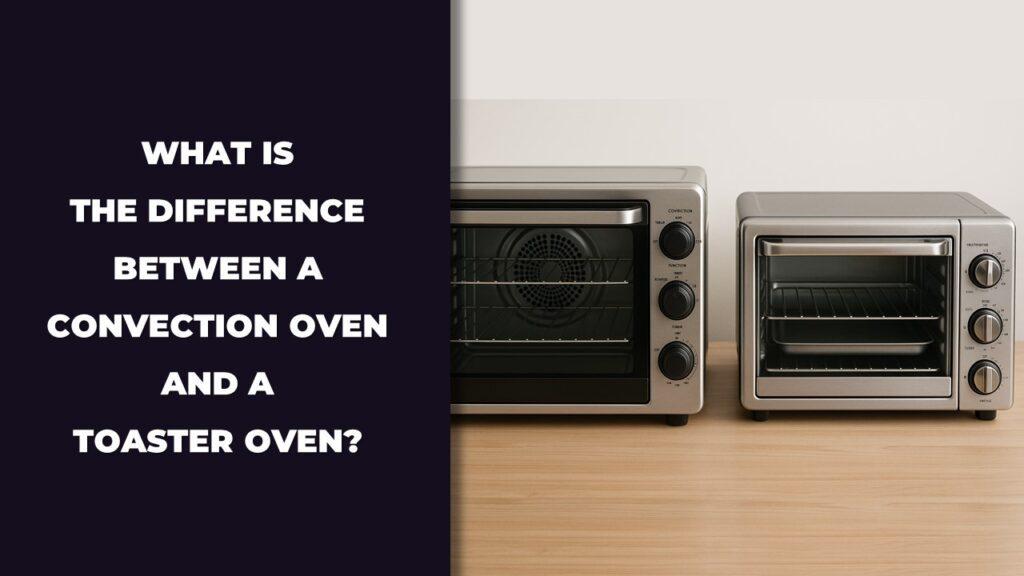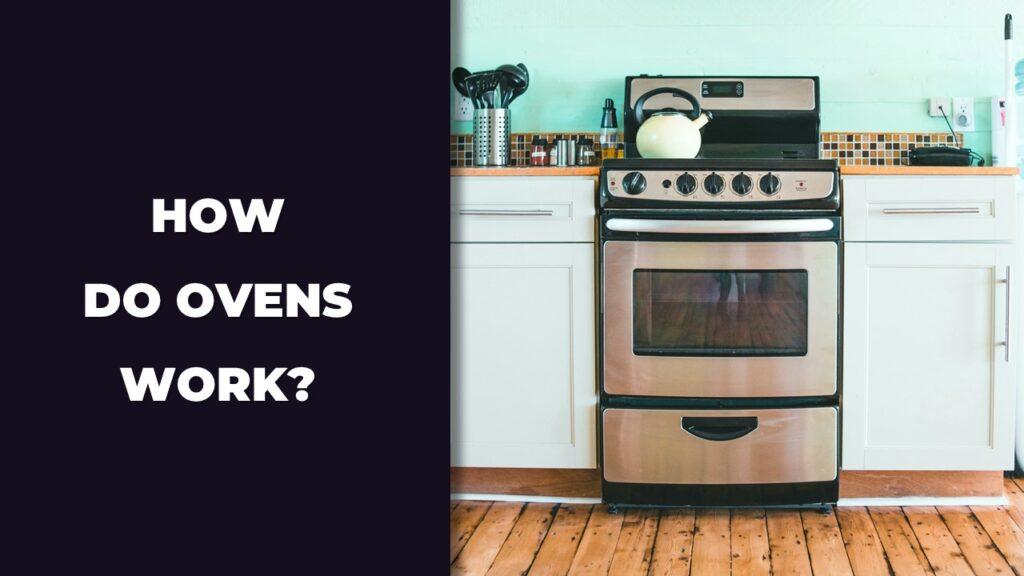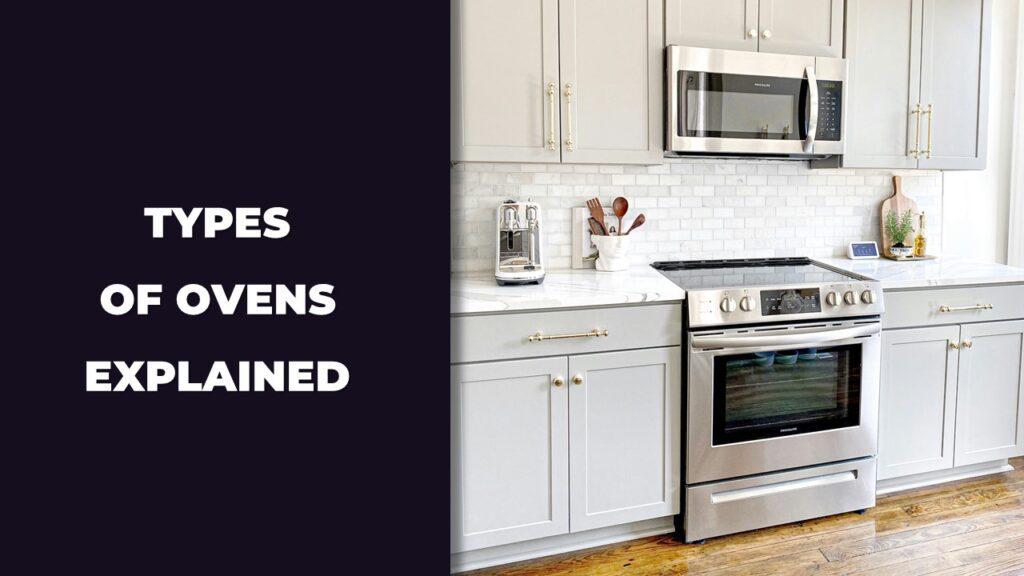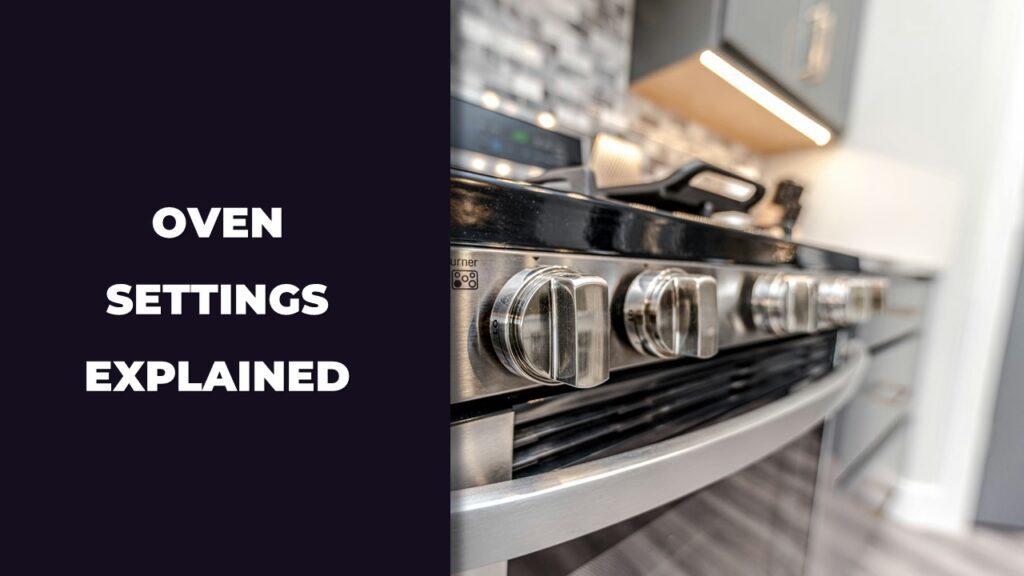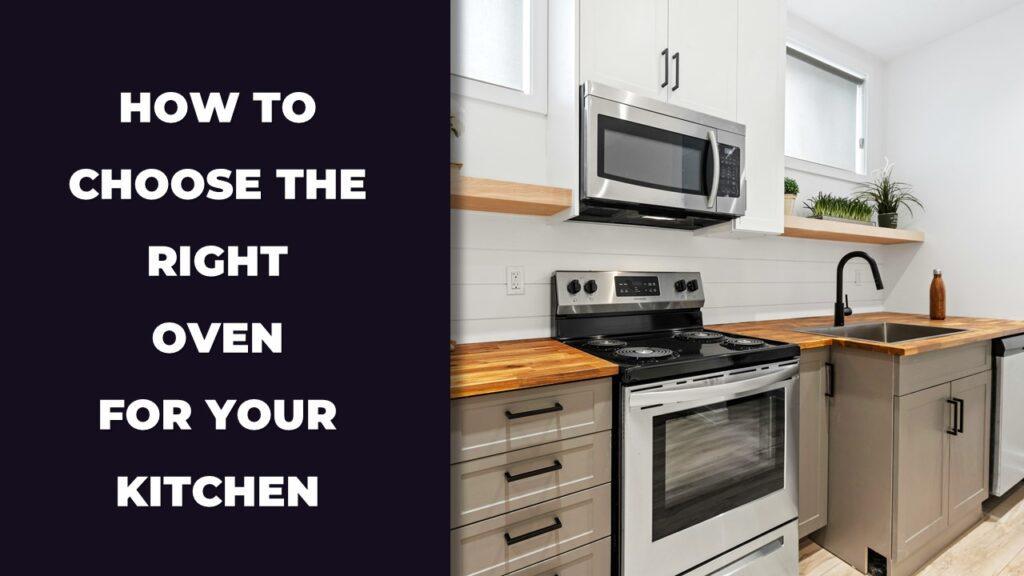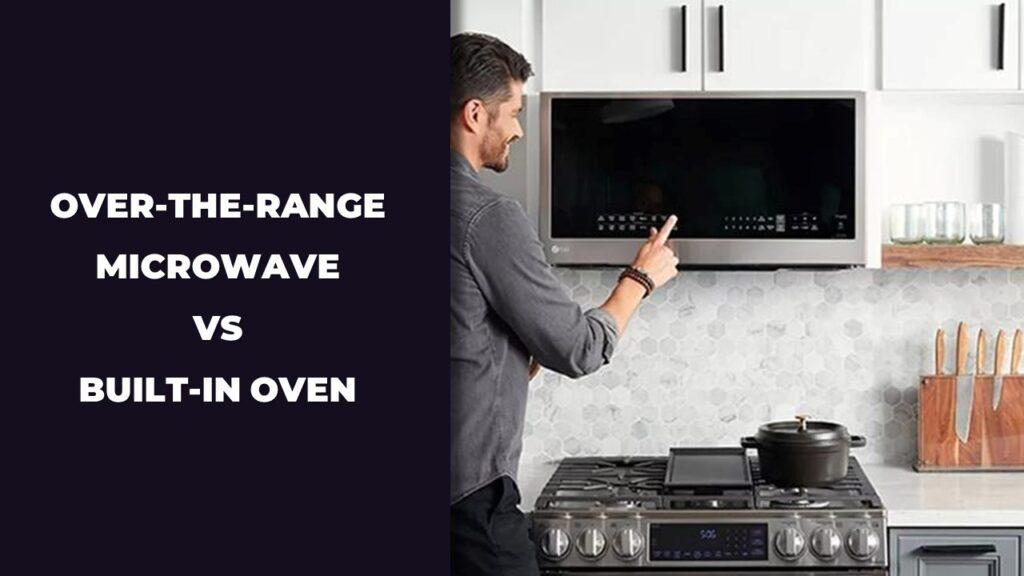
An over-the-range microwave sits above your stove and works as both a microwave and a vent hood, helping you cook and clear out steam at the same time. A built-in oven is installed into your wall or cabinet and is mainly used for baking, roasting, and bigger cooking tasks. One saves space and handles quick meals, the other gives you more power and a cleaner kitchen look.
This article will help you figure out which one fits your kitchen better. We’ll compare their features, space needs, cost, cooking use, and more.
What Is an Over-the-Range Microwave?
An over-the-range microwave is a two-in-one appliance that sits above your stove and works as both a microwave and a built-in vent hood. It heats or cooks food like a regular microwave while also pulling steam, smoke, and odors away from the cooktop through its ventilation system.
This type of microwave is a smart way to save counter space, especially in small kitchens. It mounts directly between cabinets over your range, combining two common appliances into one. The built-in fan system can either vent air outside or recirculate it through a filter, depending on your setup.
Besides reheating leftovers, over-the-range microwaves often come with preset cooking modes, lighting for the stovetop, and sometimes convection cooking features. They’re a good fit for people who want convenience without giving up kitchen space. Just keep in mind, they’re placed higher up, which might be tough to reach for kids or shorter adults.
What Is a Built-In Oven?
A built-in oven is a kitchen appliance installed directly into your wall or cabinetry, designed for baking, roasting, and slow cooking. Unlike a microwave, it doesn’t sit on your counter or go above your stove. It’s fixed in place and usually part of a larger, more custom kitchen layout.
This type of oven is made for serious cooking. It offers larger capacity, better heat distribution, and more control for cooking everything from casseroles to holiday meals. Many people pair it with a separate built-in microwave for a matching look and convenient meal prep setup.
Built-in ovens come in different styles, including single, double, and even combination models with smart cooking options. Because they’re installed at eye level or lower, they’re easier to load and unload. They also create a seamless look in your kitchen, which many homeowners prefer for design and function.
Key Differences Between Over-the-Range Microwaves and Built-in Ovens
Over-the-range microwaves combine a microwave and vent hood into one unit, saving counter space and helping remove steam and odors from above the cooktop. Built-in ovens are installed into a wall or cabinet and are used mainly for baking, roasting, and larger meals. The main difference comes down to function and placement—one is for quick heating and ventilation, the other is for full-scale cooking and seamless design.
While both are installed into your kitchen layout, they serve very different roles and fit different types of cooking habits. Let’s break it down further.
Quick Comparison Table
| Feature | Over-the-Range Microwave | Built-in Oven |
| Primary Function | Microwave + Ventilation | Baking, Roasting, and Full-Meal Cooking |
| Installation Location | Above the cooktop | Built into wall or cabinet |
| Cooking Capability | Quick heating, light meals | Advanced cooking with better heat control |
| Ventilation | Built-in fan (ducted or recirculating) | Usually no external venting needed |
| Space Saving | Yes, combines two functions in one | Takes dedicated wall space |
| Accessibility | Higher placement, may be hard to reach | Eye-level or lower for easier access |
| Kitchen Design | Functional and compact | Sleek, seamless, and custom-looking |
| Typical Price Range | $100–$400 + installation | $700–$3,000+ + installation |
Function and Cooking Use
Over-the-range microwaves are made for speed and convenience. They’re perfect for reheating leftovers, cooking quick meals, and keeping your counter free. Some models include convection features, but they’re still limited in what they can do compared to a full-size oven.
Built-in ovens, on the other hand, are made for longer cooking sessions. They offer even heat for baking, roasting, and broiling. You can cook larger meals or use advanced settings like convection, air fry, or self-clean cycles, depending on the model.
Space and Installation
Over-the-range microwaves mount above your range and require upper cabinet support. They also need access to an electrical outlet and possibly a vent. Their main draw is how they combine two appliances—a microwave and a hood—into one unit.
Built-in ovens need a dedicated cabinet cut-out, often at eye or waist level. Installing one can involve electrical rewiring or cabinetry changes, especially if you’re upgrading from a freestanding model. While it takes up more wall space, it also frees up the range area for a separate cooktop or more storage.
Design and Accessibility
An over-the-range microwave adds function but may be harder to reach, especially for kids or people with limited mobility. You’ll need to lift dishes high, which can be risky with hot food.
A built-in oven is easier to access, especially if installed at a comfortable height. It blends into the kitchen layout, giving you a modern, built-in look. Some homeowners even pair it with a microwave drawer for extra flexibility without crowding the space.
Which Appliance Fits Your Kitchen Layout?
An over-the-range microwave is a great fit for small or space-limited kitchens where saving counter space matters most. A built-in oven is better suited for larger kitchens with dedicated cabinetry or for homeowners designing a more custom layout. The right choice depends on how your kitchen is set up and how much flexibility you have with appliance placement.
Let’s break it down by kitchen type and layout considerations.
Small or Compact Kitchens
If your kitchen is short on counter or cabinet space, an over-the-range microwave makes a lot of sense. It combines a microwave and range hood in one unit, so you don’t need to install both separately. This is a great way to keep your counters clear and still get basic ventilation above your cooktop.
In rental units or apartments, this setup is also easier to install or replace without major remodeling. It’s a practical option that helps you make the most of limited square footage.
Large or Custom Kitchen Layouts
Built-in ovens shine in open or custom kitchen layouts where there’s room to work with. You can install the oven at a comfortable height and pair it with a wall-mounted microwave, drawer microwave, or separate cooktop. This gives you flexibility in design and workflow.
Many homeowners choose a built-in oven for aesthetic reasons, but also because it separates cooking zones. If you regularly bake, roast, or cook for a family, a built-in layout gives you more freedom and better cooking performance without crowding your range area.
Design, Style, and Home Value Impact
Built-in ovens usually give your kitchen a cleaner, more seamless look that can make the space feel more modern and high-end. Over-the-range microwaves are more functional in appearance but can still match well with a practical kitchen design. When it comes to long-term value, built-ins tend to add more appeal for future buyers.
Here’s how each appliance affects your kitchen’s design and resale value:
- Built-In Ovens:
- Blend smoothly into cabinetry
- Offer a more polished, designer look
- Common in higher-end kitchen remodels
- Can increase home appeal and resale value
- Over-the-Range Microwaves:
- More visible, utility-focused design
- Work well in traditional or space-conscious kitchens
- Typically seen as practical, not premium
- May not add much to home value but offer everyday convenience
Both appliances serve their purpose, but if you’re aiming for a luxury look or remodeling for resale, the built-in oven has the edge.
Cost Comparison And Lifespan
Over-the-range microwaves are usually more affordable up front and easier to install, making them ideal for tighter budgets. Built-in ovens, while more expensive, offer better cooking performance and can last longer when maintained. If you’re comparing total investment and longevity, each option delivers value differently depending on how much you cook and how your kitchen is set up.
Here’s how they break down in real-world numbers.
Appliance Price Range
Over-the-range microwaves typically cost between $150 and $450 depending on size, brand, and added oven features like convection cooking or steam sensor modes. For example, a Whirlpool 1.9 cu. ft. model with a vent system and LED lighting can cost around $280–$330.
Built-in ovens start around $750 for a basic single wall oven and can go beyond $3,500 for double ovens with smart features or European-style brands like Bosch or Miele. If you’re adding a matching built-in microwave above, that’s often another $500 to $1,200, depending on size and finish.
Estimated appliance-only price comparison:
- Budget OTR microwave setup: $250
- Mid-range built-in oven + microwave: $2,000
- High-end built-in combo setup: $4,500+
Installation And Maintenance Costs
Installing an over-the-range microwave typically costs between $100 and $250, especially if you’re replacing an old one and the venting setup already exists. However, if you’re upgrading from a countertop model or adding external venting, you may pay $300 to $500+ for ductwork and cabinet modification.
Installing a built-in oven is more complex. You’ll likely need a professional electrician to handle wiring (most built-ins are 240V) and possibly a carpenter to modify cabinets. Labor charges vary by region, but a realistic breakdown might look like this:
- Cabinet cutting/adjustment: $200–$400
- Electrical upgrade: $150–$300
- Oven installation: $150–$250
- Total install cost for built-in oven: $500–$950
- Add $100–$200 more if you’re installing a matching built-in microwave
Tip: Always check local code requirements for built-in appliances. The U.S. Department of Energy offers trusted guidance on appliance installation, electrical safety, and choosing energy-efficient models that may qualify for rebates.
Maintenance Tip: Over-the-range microwaves may need vent filter replacements every 6–12 months, which cost around $10–$20 each. Built-in ovens might require seal replacements or thermostat recalibration every few years, usually under $100 if caught early.
Expected Lifespan And Durability
Over-the-range microwaves usually last 7 to 10 years, depending on use and ventilation care. If used daily for reheating and light cooking, you can expect closer to 8 years. Microwave fans and lights often wear out first, but replacing those costs less than $50 in most cases.
Built-in ovens typically last 12 to 16 years when maintained properly. They’re built to handle higher heat and more frequent use. If you use yours multiple times a week for baking or roasting, schedule a routine checkup every few years to catch issues early.
Estimated cost of ownership (10 years):
- OTR microwave (unit + install + filter changes): $300 + $150 + $100 = $550
- Built-in oven (unit + install + minor service): $1,500 + $700 + $150 = $2,350
While the oven costs more up front, it also gives more flexibility, power, and longevity, especially if cooking is a big part of your routine.
Real Energy Cost Example (Using U.S. National Averages)
According to the U.S. Department of Energy, the average residential electricity rate is around $0.15 per kWh.
- Microwave (1,000W): 1 hour/day × 1 kWh × $0.15 = $0.15/day or $54.75/year
- Built-in Oven (3,000W):1 hour/day × 3 kWh × $0.15 = $0.45/day or $164.25/year
You can calculate your personalized energy use with the official Energy Saver Appliance Calculator by Energy
Over-the-Range Microwave vs Built-in Oven – Pros and Cons
Over-the-range microwaves are space-saving, quick to install, and cost-effective. Built-in ovens offer higher performance, better ergonomics, and a modern finish that can add value to your kitchen. Your choice really depends on your kitchen layout, cooking habits, and how much you’re ready to invest.
Here’s a closer look at the real advantages and trade-offs of each.
Pros And Cons Of Over-the-Range Microwaves
Pros:
- Combines microwave and range hood in one unit
- Saves about 4–6 square feet of countertop space
- Great for apartments or small kitchens
- Easy to install if replacing an older OTR model
- Can be found under $400 with good features
Cons:
- Can be hard to reach safely, especially when pulling out hot food
- Built-in fan is usually weaker than dedicated range hoods
- Limited capacity (usually 1.5–2.0 cu. ft.) and cooking strength
- Most don’t support advanced cooking methods like air fry or convection
Pros And Cons Of Built-in Ovens
Pros:
- Offers larger capacity (usually 4.3–5.0 cu. ft.)
- Supports serious cooking: baking, roasting, broiling, and slow cooking
- Looks clean and modern when integrated with cabinets
- Can be paired with built-in microwave or drawer for maximum flexibility
- Better resale appeal in updated or high-end kitchens
Cons:
- Base cost + installation can reach $2,500 or more
- Repairs and replacements are harder if unit is built into cabinets
- Requires more wall or cabinet space
- Not ideal for renters or temporary setups
Both appliances have a place in modern kitchens. If you’re outfitting a rental or working with a small footprint, the over-the-range microwave is the practical go-to. If you’re building a dream kitchen or cooking daily for a household, the built-in oven setup is worth every dollar.
When Should You Choose One Over The Other?
Choose an over-the-range microwave if you’re tight on space, need basic cooking functions, and want a microwave with built-in ventilation. Go for a built-in oven if you cook larger meals, care about kitchen design, or want stronger baking and roasting performance. The right pick depends on how much you cook, how your kitchen is laid out, and what kind of setup makes life easier.
Let’s look at a few situations where each appliance makes more sense.
Choose an Over-the-Range Microwave If…
- You’re working with limited space. Small kitchens benefit from the microwave and vent combo in one spot.
- You mostly reheat, defrost, or cook quick meals. Perfect for everyday convenience, not heavy-duty cooking.
- You’re replacing an older OTR unit. Installation is usually fast and low-cost if your cabinet and venting are already set up.
- You’re on a tighter budget. With models under $400 and minimal install fees, it’s a cost-effective upgrade.
Choose a Built-in Oven If…
- You cook full meals regularly. Baking, roasting, and holiday dinners are much easier in a full-size oven.
- You’re remodeling or building a custom kitchen. Built-ins offer layout flexibility and a seamless finish.
- You want long-term performance and design value. These ovens last longer and add resale appeal to your home.
- You prefer ergonomic placement. You can install it at eye level or pair it with a microwave drawer for convenience.
Final Thoughts
When it comes to over-the-range microwave vs built-in oven, the decision is really about how you cook and what kind of space you’re working with. Over-the-range microwaves are all about function and efficiency, giving you a microwave and vent in one compact unit. They’re ideal for smaller kitchens or anyone who mostly uses the microwave for simple tasks.
Built-in ovens, on the other hand, are a solid choice if you bake, roast, or entertain often. They add a sleek, professional feel to your kitchen and give you more flexibility in both cooking and layout. If you’ve got the room and the budget, a built-in oven setup often pays off over time.
No matter which option you go with, the best appliance is the one that matches your kitchen layout, your cooking routine, and how you want your kitchen to feel day to day.
Related FAQs
Can I Replace An Over-The-Range Microwave With A Built-In Oven?
Not directly. Built-in ovens are larger, heavier, and need a wall cabinet or base cabinet cutout. You’ll likely need to remove upper cabinets and reconfigure the space.
Do Built-In Ovens Include A Microwave?
No, built-in ovens and built-in microwaves are usually sold separately. You can pair them together, often in a stacked layout, but they serve different functions.
Which Lasts Longer: Over-The-Range Microwave Or Built-In Oven?
Built-in ovens generally last longer, often 10 to 15 years or more. Over-the-range microwaves usually last around 7 to 10 years with regular use and care.
Do Both Require Ventilation?
Over-the-range microwaves have built-in vents and may need external ducting. Built-in ovens don’t usually require external venting, but they need space for airflow inside the cabinet.
Which Is More Energy-Efficient?
Over-the-range microwaves are more energy-efficient for short cooking tasks like reheating. Built-in ovens use more power but are better for large meals or baking multiple items at once.

Max Fletcher is a self-taught electrician-turned-baker who combines technical know-how with a love for baking to help readers get the most from their ovens. Drawing on years of electrical experience and hands-on kitchen testing, he shares practical guides and reviews on oven performance, safety, and baking results, all with the heart of a family man who believes great food starts with understanding your tools.

